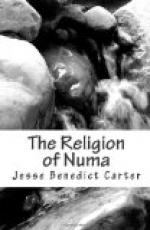But the most interesting and curious thing about this old religion is not so much what it does contain as what it does not. It is not so much what we find as what we miss, for more than half the gods whom we instinctively associate with Rome were not there under this old regime. Here is a partial list of those whose names we do not find: Minerva, Diana, Venus, Fortuna, Hercules, Castor, Pollux, Apollo, Mercury, Dis, Proserpina, Aesculapius, the Magna Mater. And yet their absence is not surprising when we realise that almost all of the gods in this list represent phases of life with which Rome in this early period was absolutely unacquainted. She had no appreciable trade or commerce, no manufactures or particular handicrafts, and no political interests except the simple patriarchal government which sufficed for her present needs. Her gods of water were the gods of rivers and springs; Neptune was there, but he was not the ocean-god like the Greek Poseidon. Vulcan, the god of fire, who was afterwards associated with the Greek Hephaistos and became the patron of metal-working, was at this time merely the god of destructive and not of constructive fire. Even the great god Juppiter who was destined to become almost identical with the name and fame of Rome was not yet a god of the state and politics, but merely the sky-god, especially the lightning god, Juppiter Feretrius, the “striker,” who had a little shrine on the Capitoline where later the great Capitoline temple of Juppiter Optimus Maximus was to stand. Another curious characteristic of this early age, which, I think, has never been commented on, is the extraordinarily limited number of goddesses. Vesta is the only one who seems to stand by herself without a male parallel. Each of the others is merely the contrasted potentiality in a pair of which the male is much more famous, and the only ones in these pairs who ever obtained a pronounced individuality did so because their cult was afterwards reinforced by being associated with some extra-Roman cult. The best illustration of this last is Juno.




